Introduction
Iron stains can be a common and frustrating issue, leaving unsightly marks on various surfaces and fabrics. These stains are often caused by the presence of iron-rich minerals in water or the oxidation of iron-containing materials. Luckily, there are several substances and methods available to effectively dissolve and remove iron stains. In this guide, we will explore different ways to tackle iron stains, discussing specific substances, their properties, and how to use them. By understanding these methods, you can confidently address iron stains and restore surfaces to their original appearance.

What can dissolve iron stains?
Lemon Juice
1.1. Natural Acidic Properties
Lemon juice is a natural and readily available substance that can effectively dissolve iron stains. Its high citric acid content acts as a mild acid, capable of breaking down iron deposits and lifting stains.
1.2. Direct Application
To use lemon juice for iron stain removal, squeeze fresh lemon juice onto the stained area. Allow it to sit for a few minutes, then scrub the stain gently using a soft cloth or sponge. Rinse with water and repeat the process if necessary.

Vinegar
2.1. Acetic Acid Power
Vinegar, particularly white vinegar, contains acetic acid, which is a powerful cleaning agent. This acid helps break down iron deposits and remove stains effectively.
2.2. Application Techniques
To use vinegar for iron stain removal, create a solution by mixing equal parts of vinegar and water. Apply the solution directly to the stained area. Allow it to sit for a few minutes, then scrub the stain gently with a cloth or sponge. Rinse thoroughly with water afterward.
Baking Soda
3.1. Abrasive and Neutralizing Properties
Baking soda is known for its gentle abrasive qualities, making it effective at removing iron stains. It can also help neutralize acidic or basic reactions caused by other cleaning substances.
3.2. Cleaning Method
Create a paste by mixing baking soda with water. Apply the paste to the iron stain and gently scrub the area using a soft cloth or sponge. Rinse thoroughly with water to remove any residue.

Oxalic Acid
4.1. Powerful Stain Remover
Oxalic acid is a highly effective substance for removing iron stains. It can be found in some commercial cleaning products or as a standalone powder. However, caution should be exercised when handling and using oxalic acid, as it can be toxic if ingested or inhaled.
4.2. Safety Precautions
When using oxalic acid, always follow the manufacturer’s instructions and safety guidelines. Wear protective gloves and eyewear to prevent direct contact with the substance. Mix the oxalic acid powder with water according to the recommended ratio and apply it to the stained area. Allow it to sit for a few minutes, then scrub gently with a cloth or sponge. Rinse thoroughly with water afterward.
Commercial Iron Stain Removers
5.1. Ready-to-Use Products
There are various commercial iron stain removers available on the market that are specifically formulated to dissolve and remove iron stains. These products typically contain a combination of acids, surfactants, and other cleaning agents to effectively tackle iron deposits.
5.2. Usage Guidelines
When using a commercial iron stain remover, carefully read and follow the instructions provided by the manufacturer. Apply the product to the stained area, allowing it to penetrate the stain according to the recommended time frame. Gently scrub the area with a cloth or sponge, then rinse thoroughly with water.
Preventive Measures
6.1. Water Softening
Iron stains on surfaces can be prevented by addressing the root cause of the problem, which is often iron-rich water. Installing a water softener or using a water conditioner can help remove or reduce iron content in the water, minimizing the occurrence of iron stains.
6.2. Regular Cleaning
Regular cleaning and maintenance can help prevent the buildup of iron deposits and stains.
6.3. Protective Measures
To prevent iron stains on fabrics, consider using protective measures such as ironing fabrics inside out or placing a cloth between the iron and the fabric to prevent direct contact.

Surface-Specific Approaches
7.1. Porcelain and Ceramic Surfaces
For porcelain and ceramic surfaces, a paste made of baking soda and water can be applied directly to the stain. Allow the paste to sit for a few minutes, then scrub gently with a non-abrasive cloth or sponge. Rinse thoroughly with water.
7.2. Clothing and Fabrics
When dealing with iron stains on clothing and fabrics, it is crucial to check the care label for any specific instructions. Pre-treat the stain by applying lemon juice or vinegar directly to the affected area. Allow it to sit for a few minutes, then launder the fabric as usual. Repeat the process if necessary.
7.3. Carpets and Upholstery
To remove iron stains from carpets and upholstery, start by blotting the stain with a clean, white cloth to absorb any excess liquid. Mix a solution of equal parts vinegar and water, and apply it to the stain using a clean cloth. Blot the area gently, working from the outside of the stain inward, until the stain is lifted. Rinse the area with water and blot dry.
Hard Water Stain Removers
8.1.1. Application Technique
To remove hard water stains, mix citric acid powder with water according to the instructions on the packaging. Apply the solution to the stained area and let it sit for a few minutes. Scrub the stain gently with a cloth or sponge, then rinse thoroughly with water to remove any residue.
8.2.1. Oxidizing Agent
Hydrogen peroxide is a versatile substance that can be used to remove a variety of stains, including hard water stains. It acts as an oxidizing agent, breaking down and loosening mineral deposits.
8.2.2. Safe Application
To use hydrogen peroxide for hard water stain removal, apply it directly to the stained area and let it sit for a few minutes. Scrub the stain gently with a cloth or sponge. Rinse thoroughly with water afterward.

Conclusion
Iron stains can be a nuisance, but with the right substances and methods, they can be effectively dissolved and removed. Lemon juice and vinegar are natural options that harness the power of acidity to break down iron deposits. Baking soda serves as a gentle abrasive and can neutralize reactions caused by other cleaning substances. Oxalic acid and commercial iron stain removers are potent options for stubborn stains, but caution should be exercised when handling them. Preventive measures such as water softening and regular cleaning can help minimize the occurrence of iron stains. By implementing these strategies, you can confidently address iron stains and restore surfaces to their original condition.

